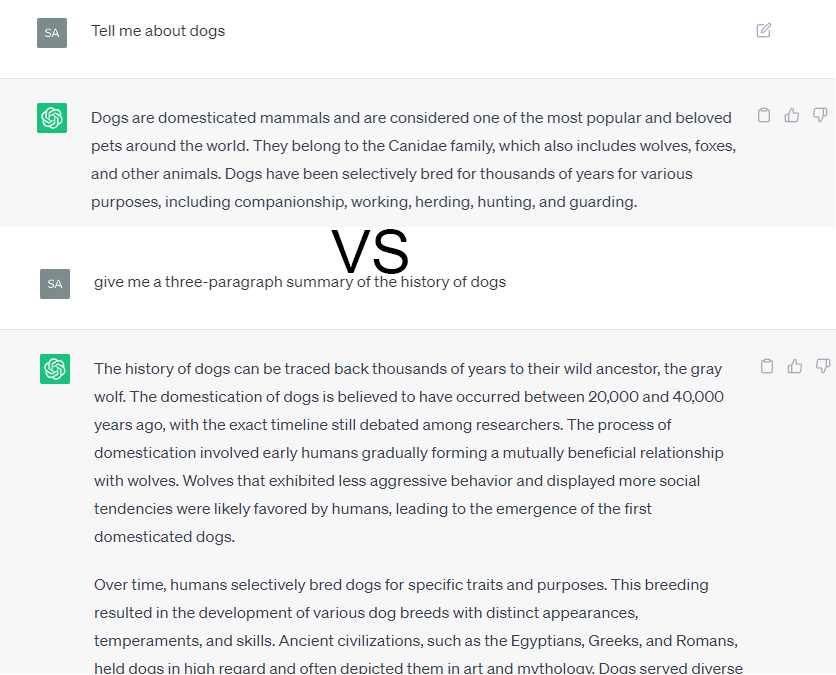The Power and Importance of Prompts
Understanding the concept of prompts is essential in the world of artificial intelligence (AI). In AI applications, particularly in natural language processing models like OpenAI's ChatGPT, prompts are user inputs that guide the AI's output. The interaction you have with an AI, the effectiveness and efficiency of the dialogue, are significantly determined by the quality of your prompts. But what exactly are prompts?
Prompts are the initial instructions or questions that guide the AI in generating responses. Think of it as the starter in a conversation or the question in an interview. It sets the direction of the conversation and gives the AI a framework within which to work. As such, the AI's ability to generate a meaningful, relevant, and creative response greatly depends on the quality and clarity of the prompts it receives.
The mastery of creating effective prompts can drastically enhance your experience with ChatGPT. It improves the relevance and context of the responses, fostering a smoother, more valuable engagement with the AI model. This is important because the potential uses of AI like ChatGPT are vast, from content creation and brainstorming to customer service and personal assistants. The better you can communicate with the AI, the better it can assist you in these tasks.
The art of crafting effective prompts is not just about improving your interaction with AI; it's also about understanding and communicating your ideas, questions, and tasks more clearly. It's an opportunity to think more deeply about what you're looking for and how to phrase it in a way that produces the desired results.
In this guide, we will delve deeper into the mechanics of prompt creation. We will explore the format and length considerations and provide strategies to improve the quality of your dialogue with ChatGPT. But remember, learning to write effective prompts is a process that involves understanding, practice, and a willingness to experiment and learn.
Understanding the Function of Prompts in ChatGPT
To craft effective prompts, it's crucial to understand how ChatGPT, the language model we're focusing on, works. Built by OpenAI, ChatGPT is a large-scale machine learning model trained to predict what comes next in a piece of text. Given a series of words, or tokens, it generates the next word, then takes that output, adds it to the input, and repeats the process.
Imagine having a stack of books and being asked to predict the next word on a page given all the previous words. That's essentially what ChatGPT does, but on a much larger scale and at a much higher speed. It has been trained on a diverse range of internet text, but it doesn't know specifics about which documents were part of its training set or have access to any personal data unless explicitly provided during the conversation. As such, it generates responses based on patterns and information it has learned, not on any understanding or consciousness.
When you provide a prompt, you're setting the initial conditions for ChatGPT's text generation process. The more clearly and effectively you set these conditions, the more likely you are to receive the response you want. Understanding this is crucial because it informs how we approach prompt writing. It's not about finding a magic phrase but understanding the logic of language and communication that the model follows.
Writing effective prompts for ChatGPT is therefore a balance of art and science. It's about understanding the model's strengths and limitations, and then crafting prompts that leverage these strengths and work around the limitations. It's also about understanding the nuances of language and communication and creatively applying this understanding to guide the model towards the desired output.
The Art and Science of Crafting Superior ChatGPT Prompts: Strategies and Techniques
Creating prompts that evoke the desired response from ChatGPT is both a science and an art. It necessitates a clear vision of the expected outcome and an understanding of how the AI model interprets and processes the input. Let's delve into strategies and techniques that can help you create more effective prompts:

- Explicitness and Detail: The performance of an AI model largely depends on the input it receives. If a prompt lacks specificity, the responses may be vague or even off-target. Consider specifying the format of the desired answer or providing examples of what you're looking for. For instance, instead of asking, "Tell me about dogs," you might say, "Give me a three-paragraph summary of the history of domestic dogs."
- Contextual Clarity: Context is crucial in communication, whether between humans or with AI. Including relevant context in your prompts can lead to more appropriate and meaningful responses. For instance, if you're asking ChatGPT to help draft a business email, providing information about the recipient, your relationship with them, and the purpose of the email can guide the AI to generate a more suitable response.
- Tone Guidance: You can influence the tone of the AI's responses by specifying the desired tone in your prompt. This could be particularly useful when creating content for different audiences or purposes. For instance, you could preface your prompt with, "In a humorous tone, write a brief article about the daily life of a software developer."
Understanding these strategies and techniques is the first step to creating better prompts. But remember, crafting effective prompts is an iterative process that requires practice and experimentation. So don't be discouraged if your initial attempts don't produce perfect results. Keep trying, learning, and refining, and you'll get better over time.
Exploring the Optimal Format for ChatGPT Prompts
While there isn't a fixed format for ChatGPT prompts, certain practices can yield better responses.
One effective practice is starting your prompt with a clear request or instruction, followed by necessary details or context. A well-structured prompt guides the AI model effectively, resulting in a response that aligns more closely with your expectations and requirements.
You could enhance this prompt further by providing more specific context or instructions. For instance: "Write a professional email to a client named Alex, who we met at a conference last week. In the email, express appreciation for their time, recap the main points we discussed about the project, and propose a phone call next week to discuss the project further."
Remember, however, that there's no one-size-fits-all approach. The optimal format for your prompt will depend on the specific task, the complexity of the request, and the desired output. Experiment with different formats and see what works best for your needs.
Length Considerations for ChatGPT Prompts
When writing prompts for ChatGPT, it's important to consider length. The model operates within a token limit, currently set at 4,096 tokens for GPT-3. Tokens can be as short as one character or as long as one word.
Both the prompt and the response contribute to this total. Therefore, an overly lengthy prompt could limit the length of the response. On the other hand, a prompt that's too short might not provide enough information for the model to generate a useful response.
Striking a balance between a prompt that's too short and one that's too long is key. Generally, a concise but comprehensive prompt that provides all necessary information typically yields the best interaction with ChatGPT.
The Continuous Learning Journey: Refining Your Interaction with ChatGPT
Creating effective prompts is a continuous learning process. As you interact more with ChatGPT, you'll start to recognize what strategies and prompt styles work best for you.
This isn't an overnight process. It's akin to learning a new language. But with every interaction, you'll get one step closer to mastering the language of AI interaction.
Remember, there's always room for improvement, and the journey is just as important as the destination. Stay curious, keep experimenting, and with each interaction, you will uncover new strategies and insights that will take your AI interactions to the next level.
In the end, writing effective prompts for ChatGPT is about more than just getting the right responses. It's about honing your ability to communicate effectively, ask the right questions, and clarify your thoughts. It's a journey of learning and discovery, one that can enrich your understanding of language, communication, and AI. So embrace the process, keep learning, and enjoy the journey!





